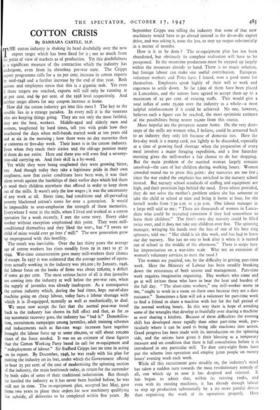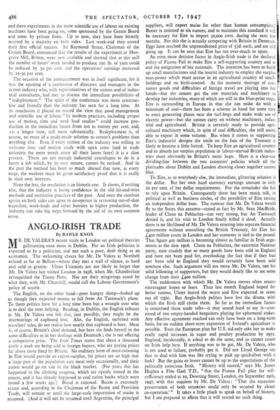COTTON CRISIS
By BARBARA CASTLE, M.P.
THE cotton industry is shaking its head doubtfully over the new export target which has been fixed for it ; not so much from the point of view of markets as of production. Yet this doubtfulness is a significant measure of the contraction which the industry has undergone, even from its shrunken pre-war state. The Cripps export programme calls for a to per cent. increase in cotton exports by mid-1948 and a further increase by the end of that year. Both unions and employers stress that this is a gigantic task. Yet even if these targets are reached, exports will still only be running at 56 per cent. and 69 per cent, of the 1938 level respectively. And neither target allows for any coupon increase at home.
How did the cotton industry get into this mess ? The key to the trouble lies in a strange paradox. In every mill it is the veterans who are keeping things going. They are not only the most faithful, they are the best, workers. Middle-aged and elderly men and women, toughened by hard times, tell you with pride how they weathered the days when mill-hands started work at ten years old and at six in the morning ; how there were no day nurseries then or canteens or five-day week. Their heart is in the cotton industry. Even when they reach their sixties and the old-age pension many of them do not retire. Here and there you will even find a seventy- year-old carrying on. And their skill is a by-word..
Yet while they were being toughened they were growing bitter, too. And though today they take a legitimate pride in their own toughness, now that easier conditions have been won, it was their silent revolt against the hardships of their earlier days which led them to send their children anywhere that offered in order to keep them out of the mills. It wasn't only the low wages ; it was the uncertainty of any work at all. Short time, bad conditions and all-pervading poverty blackened cotton's name for over a generation. It would be impossible to over-emphasise the strength of these memories. Everywhere I went in the mills, when I lived and worked as a cotton operative for a week recently, I met the same story. Every older worker without exception emphasised this point. They were mill- conditioned themselves and they liked the wor,,, but "I swore no child of mine would ever go into t' mill." The new generation grew up impregnated with this hostility.
The result was inevitable. Over the last thirty years the average age of cotton workers has risen steadily from 29 in 1911 to 37 in 1944. War-time concentration gave many mill-workers their chance of escape. In 1937 it was estimated that the average number of opera- tives actually working in the industry was 363,000 ; by January, 1946, the labour force on the books of firms was about 226,000, a deficit of some 40 per cent. The most serious factor of all is that juveniles are coming into the industry at well below the pre-war rate, when the supply of juveniles was already inadequate. As a consequence the cotton industry which, during the bad times, kept out-of-date machine going on cheap labour, today faces a labour shortage with which it is ill-equipped, mentally as well as mechanically, to deal.
We must now accept the fact that the normal post-war trend back to the industry has shown its full effect and that, as far as any automatic recovery goes, the industry has "had it." Demobilisa- tion, recruitment campaigns among juveniles, adult training schemes and inducements such as flat-rate wage increases have together brought the labour force up to some 260,000, or still about too,000 short of the force needed. It was on an estimate of these figures that the Cotton Working Party based its call for re-equipment and "redeployment of labour." Sir Stafford Cripps lost no time in acting on its report. By December, 1946, he was ready with his plan for putting the industry on its feet, under which the Government offered to bear 25 per cent. of the cost of modernising the spinning section of the industry, the main bottleneck today, in return for the surrender by both sides of some of their traditional isolationism. But though he hustled the industry as it has never been hustled before, he was still not in time. The re-equipment plan, accepted last May, gave firms two years to place their orders for new machinery qualifying for subsidy, all deliveries to be completed within five years. By September Cripps was telling the industry that some of that new machinery would have to go abroad instead in the do-or-die export drive, and was asking it, none the less, to step up output substantially in a matter of months.
How is it to be done ? The re-equipment plan has not been abandoned, but obviously its complete realisation will have to be postponed. In the meantime production must be stepped up largely within the resources already to hand. There is no magic solution, but foreign labour can make one useful contribution. European volunteer workers and Poles have, I found, won a good name for themselves. Employers speak highly of their will to work and eagerness to settle down. So far 2,600 of them have been placed in Lancashire, and the unions have agreed to accept them up to a maximum of so per cent, of existing staffs. This would give a total influx of some 25,000 over the industry as a whole—a most helpful reinforcement if it could be achieved. No one, however, believes such a figure can be reached, the most optimistic estimate of the possibilities being nearer ro,000 from this source.
More hopeful are the prospects nearer home. On the very door- steps of the mills are women who, I believe, could be attracted back to an industry they only left because of domestic ties. Here the five-day week is a trump card, not lightly to be discarded, especially at a time of growing food shortage when the preparation of every meal involves a major foraging expedition, and a free Saturday morning gives the mill-worker a fair chance to do her shopping. But the main problem of the married woman largely remains unsolved—the care of her children during working hours. Women crowded round me to press this point : day nurseries are too few ; since the war ended the emphasis has switched to the nursery school instead. But nursery school standards of staffing and equipment are high, and their provision lags behind the need. Even where provided, they do not solve the mother's problem unless she has someone to take the child to school at nine and bring it home at four, for she herself works from 7.30 a.m. to 5.30 p.m. One labour manager in a large mill said to me : "There are thousands of women in Lanca- shire who could be recruited tomorrow if they had somewhere to leave their children." The firm's own day nursery could be filled twice over, and it does not take any children over five. The spinning manager, wringing his hands over the loss of one of his best ring spinners, told me : "Her child is six this week, and has had to leave our day nursery. She has no one to look after it when it is turned out of school in the middle of the afternoon." There is scope here for improvisation on a war-time scale. Why not an extension of women's voluntary services to meet the need ?
The women are puzzled, too, by the difficulty in getting part-time work. Here the Ministry of Labour has been steadily breaking down the resistances of both unions and management. Part-time work requires imaginative organising. Day workers who come and go at will irritate those who have to bear the heat and burden of the full day. "The short-time workers," one mill-worker wrote to me, "ought to work in a room on there own because they are a dam nuisance." Sometimes a firm will ask a volunteer for part-time work to find a friend to share a machine with her for the full period of the normal working hours. In this way there is hope of avoiding some of the wrangles that develop as fruitfully over sharing a machine as over sharing a kitchen. Because of these difficulties the evening shift has developed more rapidly than other part-time work, par- ticularly where it can be used to bring idle machines into action. Good progress has been made with its introduction on the spinning side, and the unions have given it their blessing as a temporary measure and on condition that there is full consultation before it is introduced in any particular mill. To date sixty-eight firms have put the scheme into operation and employ 3,000 people on twenty hours' evening work each week.
While all this recruitment goes steadily on, the industry's mind has taken a sudden turn towards the most revolutionary remedy of all, one which up to now it has despised and rejected. It has begun to admit that, within its existing ranks, and even with its existing machines, it has already enough labour to step up production substantially by a no more painful device than organising the work of its operatives properly. Here and there experiments in the more scientific use of labour on existing machines have been going on, some sponsored by the Cotton Board and some by private firms. Up to now, they have been bitterly resisted by a majority on both sides. Last week-end they scored their first official success. Sir Raymond Streat, Chairman of the Cotton Board, announced that the results of the experiment at Mus- grave Mill, Bolton, were now available and showed that at this mill the number of hours' work needed to produce too lb. of yarn could be reduced by 30 per cent. and the operatives' earnings increased by 25-30 per cent.
The occasion of the announcement was in itself significant, for it was the opening of a conference of directors and managers in the cotton industry who, with representatives of the unions and of indus- trial consultants, had met to discuss the immediate possibilities of "redeployment." The spirit of the conference was more construc- tive and friendly than the industry has seen for a long time. At its conclusion it placed on record the view that good management and scientific use of labour "by modern practices, including proper use of motion, time and work load studies" could increase pro- duction in the immediate future from ten to twenty per cent, and, on a longer view, still more substantially. Redeployment is, of course, no more of a ready-made solution to cotton's problems than anything else. Even if every section of the industry was willing to welcome time and motion study with open arms (and in trade unionists the mere words rouse all their latent fears) it is a slow process. There are not enough industrial consultants to do in a hurry a job which, by its very nature, cannot be rushed. And in the past the method has been so much abused that now, at every stage, the workers must be given satisfactory proof that it is really in their own interests.
None the less, the resolution is an historic one. It shows, if nothing else, that the industry is losing confidence in the old hit-and-miss methods and restrictive practices of the past. And once the cautious spirits on both sides can agree to co-operate in reviewing out-of-date wage-lists, work-loads and other barriers to higher production, the industry can take big steps forward by the aid of its own common sense.



































 Previous page
Previous page